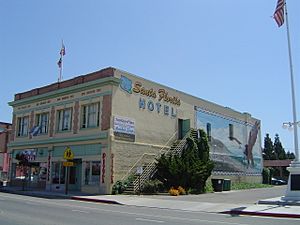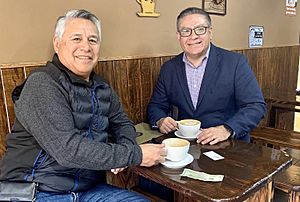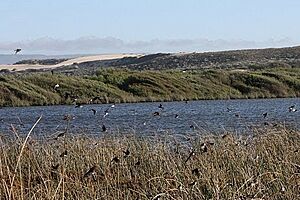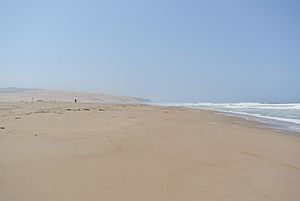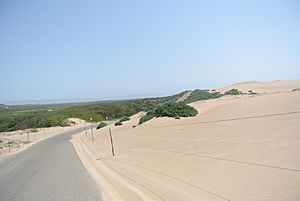Guadalupe, California facts for kids
Quick facts for kids
Guadalupe, California
|
|
|---|---|
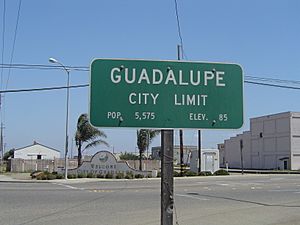
Southern city limit of Guadalupe, 2005
|
|
| Motto(s):
"Gateway to the Dunes!"
|
|
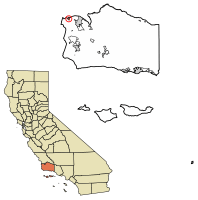
Location of Guadalupe in Santa Barbara County, California
|
|
| Country | United States |
| State | California |
| County | Santa Barbara |
| Incorporated | August 3, 1946 |
| Area | |
| • Total | 1.31 sq mi (3.41 km2) |
| • Land | 1.31 sq mi (3.39 km2) |
| • Water | 0.00 sq mi (0.01 km2) 0.40% |
| Elevation | 85 ft (26 m) |
| Population
(2020)
|
|
| • Total | 8,057 |
| • Density | 5,939.1/sq mi (2,293.09/km2) |
| Time zone | UTC-8 (Pacific) |
| • Summer (DST) | UTC-7 (PDT) |
| ZIP Code |
93434
|
| Area code | 805 |
| FIPS code | 06-31414 |
| GNIS feature IDs | 1652715, 2410672 |
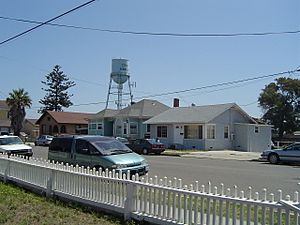
Guadalupe is a small city in Santa Barbara County, California. In 2020, about 8,057 people lived there. Guadalupe is closely connected to Santa Maria, a city about 8 miles (13 km) to the east. It sits where Highway 1 and Highway 166 meet. The city is just south of the Santa Maria River and 5 miles (8 km) east of the Pacific Ocean.
Contents
Exploring Guadalupe's Past
The first Europeans to explore Alta California were part of the Spanish Portolá expedition. They camped near where Guadalupe is today on September 1, 1769. A missionary named Juan Crespí wrote in his diary that they found "a very large lake." Over time, this lake mostly filled in. Now, it is a flat area with the Santa Maria River and other small streams.
When Mission La Purisima was built in 1787, this land became part of its grazing areas. Later, in 1840, the land became part of the Rancho Guadalupe land grant. Many different people settled Rancho Guadalupe, including those from Europe, China, the Philippines, Japan, and Mexico. The small town officially became the City of Guadalupe on May 19, 1946. Its name honors Our Lady of Guadalupe, a special title for the Virgin Mary in the Catholic faith.
A new housing project called Pasadera Homes is being built on the south side of town. It will add over 800 new homes. This project is expected to help Guadalupe grow. It could bring the city's population to 10,000 people. This number is often seen as a good size for attracting more stores and restaurants. Besides homes, the plan also includes a new school and places for businesses.
The city faced some money problems in the late 2000s and early 2010s. However, voters approved new taxes and fees. These, along with the new homes and businesses, helped make the city's economy stronger.
Guadalupe's Location and Landscape
Guadalupe is in the very northwest part of Santa Barbara County. It is right next to the Santa Maria River. The land around the city is mostly flat. People use this land mainly for farming and for producing oil. Hills rise to the south of the town. Beyond these hills is Vandenberg Space Force Base.
To the west of Guadalupe, you can find the Guadalupe-Nipomo Dunes. This is a large area of sand dunes along the Pacific Ocean. It stretches into both Santa Barbara County and San Luis Obispo County. The Guadalupe-Nipomo Dunes Center helps people learn about this natural area.
The United States Census Bureau says the city covers about 1.3 square miles (3.4 square kilometers). Almost all of this area is land, with a very small part being water. The city itself is a group of buildings surrounded by farmland.
Guadalupe's Climate
Guadalupe has warm, dry summers. The average monthly temperatures do not go above 71.6°F (22°C). This type of weather is called a warm-summer Mediterranean climate. On climate maps, it is shown as "Csb."
| Climate data for Guadalupe, California | |||||||||||||
|---|---|---|---|---|---|---|---|---|---|---|---|---|---|
| Month | Jan | Feb | Mar | Apr | May | Jun | Jul | Aug | Sep | Oct | Nov | Dec | Year |
| Record high °F (°C) | 85 (29) |
89 (32) |
91 (33) |
98 (37) |
102 (39) |
109 (43) |
104 (40) |
95 (35) |
106 (41) |
104 (40) |
94 (34) |
92 (33) |
109 (43) |
| Mean daily maximum °F (°C) | 62.2 (16.8) |
63.0 (17.2) |
64.1 (17.8) |
66.6 (19.2) |
68.4 (20.2) |
70.3 (21.3) |
71.6 (22.0) |
72.8 (22.7) |
73.2 (22.9) |
72.0 (22.2) |
67.7 (19.8) |
62.4 (16.9) |
67.9 (19.9) |
| Mean daily minimum °F (°C) | 41.6 (5.3) |
43.2 (6.2) |
44.6 (7.0) |
45.6 (7.6) |
48.2 (9.0) |
51.3 (10.7) |
54.0 (12.2) |
54.5 (12.5) |
53.6 (12.0) |
50.1 (10.1) |
45.2 (7.3) |
40.9 (4.9) |
47.7 (8.7) |
| Record low °F (°C) | 21 (−6) |
20 (−7) |
23 (−5) |
28 (−2) |
27 (−3) |
35 (2) |
31 (−1) |
40 (4) |
32 (0) |
28 (−2) |
21 (−6) |
22 (−6) |
20 (−7) |
| Average precipitation inches (mm) | 3.23 (82) |
3.48 (88) |
3.19 (81) |
0.98 (25) |
0.35 (8.9) |
0.05 (1.3) |
0.03 (0.76) |
0.04 (1.0) |
0.31 (7.9) |
0.60 (15) |
1.40 (36) |
2.29 (58) |
15.95 (405) |
People of Guadalupe
| Historical population | |||
|---|---|---|---|
| Census | Pop. | %± | |
| 1880 | 174 | — | |
| 1950 | 2,429 | — | |
| 1960 | 2,614 | 7.6% | |
| 1970 | 3,145 | 20.3% | |
| 1980 | 3,629 | 15.4% | |
| 1990 | 5,479 | 51.0% | |
| 2000 | 5,659 | 3.3% | |
| 2010 | 7,080 | 25.1% | |
| 2020 | 8,057 | 13.8% | |
| U.S. Decennial Census | |||
Population in 2010
In 2010, the 2010 United States Census counted 7,080 people in Guadalupe. Most people lived in homes, not in group living places.
There were 1,810 households. Many of these (59.3%) had children under 18 living there. About 55.5% were married couples. The average household had 3.91 people. The average family had 4.11 people.
The population included many young people. About 34.2% were under 18 years old. The median age was 28.2 years. This means half the people were younger than 28.2, and half were older. For every 100 females, there were about 101 males.
Most people in Guadalupe were of Hispanic or Latino background (86.2%). The census also reported people of various other races living in the city.
Guadalupe's Economy
Agriculture is the biggest industry in Guadalupe. Many people work in farming or manufacturing here. About 31% of workers are in agriculture. Another 24% have manufacturing jobs. Companies like Apio Inc. and Obispo Cooling process fresh produce. They prepare it to be shipped across the country and even overseas.
Most small businesses are on Guadalupe Street. The famous Far Western Tavern used to be here for 50 years. It moved in 2012. The old building was given to the Guadalupe-Nipomo Dunes Center. It will become the new home for the Dunes Center. This building is now listed on the state's Register of Historic Resources.
You can buy Groceries at La Chiquita Market and Masatani's Market. The Masatani family has owned their market since 1922. There is also a public library on Main Street. Many other shops and services are available in town.
Arts and Culture in Guadalupe
Guadalupe is a small town with a rich and varied culture. Besides the Dunes Center, it has an art museum. There is also the Rancho de Guadalupe Historical Society. You can visit the public library and a veteran's memorial. The Masatani Mansion is another interesting place.
Nuestra Señora De Guadalupe is the main Catholic church. It is on 11th Street and Obispo Street. There are three other Christian churches and a Buddhist temple in town. The building where city hall and the police department are now used to be an elementary school. There is a very small jail building near the train tracks.
Every year on September 16, Guadalupe has a parade on Guadalupe Street. This parade celebrates Mexico's independence from Spain.
The historic Royal Theater is also in Guadalupe. It was a movie theater built in 1939. It closed in the 1990s. The city now owns it and plans to make it a community arts center. They also want it to become an historic landmark.
Parks and Outdoor Fun
There is a beach near Guadalupe at the end of Main Street. It is part of the Guadalupe-Nipomo Dunes. Oso Flaco Lake is also part of these dunes. It is a few miles north of Guadalupe. It has a boardwalk that goes over the lake and leads to the Guadalupe beach.
South of Guadalupe, you can find Point Sal Road. This road is now a hiking trail through the coastal mountains. It was closed because of heavy storms. The trail is about 5 miles long. It goes through Vandenberg Space Force Base. At the end of the trail is the quiet Point Sal State Beach. Between Guadalupe Beach and Point Sal Beach is Paradise Beach, which is even more secluded.
Local parks include Jack O'Connell Park. This is where the Bulldogs youth football team practices. LeRoy Park is the city's community center. It is also home to the local Boys & Girls Club. This is the oldest community park in Santa Barbara County. The LeRoy family gave the land in 1871. The park is now being updated.
The Guadalupe Wrestling Club started in 1979 for young people. It has helped many wrestlers become state champions. The Guadalupe Police Department runs the Gladiator's club. This club helps fifth and sixth graders by having older kids mentor them. The Boys & Girls Club and the Riverview apartment tutoring program offer places for children after school.
Learning in Guadalupe
The Guadalupe Union School District runs two schools. These are Mary Buren Elementary and Kermit McKenzie Junior High School. Mary Buren Elementary teaches students from kindergarten to fifth grade. McKenzie Junior High teaches sixth grade to eighth grade. The mascot for both schools is the bobcat. There is also a preschool run by the Community Action Commission of Santa Barbara County.
Getting Around Guadalupe
Guadalupe is located where California State Route 1 and 166 meet. This makes it easy to travel to cities north, east, and south. The biggest nearby city is Santa Maria.
Amtrak trains pass through town. The Guadalupe station is on the Pacific Surfliner route. There is a large pedestrian bridge in the residential area. This bridge helps people safely cross the train tracks that divide the town.
The Guadalupe Flyer bus runs routes to Santa Maria every hour.
See also
 In Spanish: Guadalupe (California) para niños
In Spanish: Guadalupe (California) para niños



